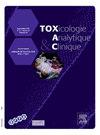How to interpret NPS findings in hair?
IF 1.7
Q4 TOXICOLOGY
引用次数: 0
Abstract
Objective
The spread of novel psychoactive substances (NPS) and novel synthetic opioids (NSO) in the worldwide drug market and their continuous increase in number and type, often with the purpose of bypassing the controlled substance legislation, represents an unceasing defy for forensic toxicologists, clinicians and enforcement authorities. This presentation will aim to provide information regarding the current state of the art for NPS analysis in hair.
Methods
The identification of NPS in biological samples is controversial, especially when the examined samples are limited, or the drug is promptly and extensively metabolized. This causes a lack of reliable literature data on the real NPS diffusion in different parts of the world and in different groups of populations. New technologies for the instrumental detection of NPS in alternative samples, namely hair, are now offering comprehensive information about the NPS use.
Results
The lack of detection and underreporting of NPS in biological samples makes it difficult to obtain complete qualitative and quantitative information about their prevalence. Instead, hair testing offers a unique perspective in the investigation of drug consumption, provided that a large panel of target analytes is considered. The prerequisite of targeted multi-analyte protocols used to investigate the diffusion of NPS/NSO is indeed that all the molecules of interest expected to be possibly present in the screened samples are included in the method. Parallelly, untargeted approaches or artificial intelligence tools have been being introduced to assist the identification of unknown compounds.
In this presentation, the available information obtainable from hair analysis and the results interpretation, in terms of trends and pattern of NPS/NSO prevalence, will be explored. In particular, (i) the diffusion of NPS/NSO, and (ii) the co-use of traditional and new drugs, will be discussed.
Discussion
One limitation of hair testing when testing for NPS/NSO is the sensitivity to detect exposure to different substances, although the technological development allows us today to achieve extremely low limits of detection when using last generation mass spectrometers. Other typical scenarios (passive exposure vs. active consumption, mindful vs. unaware intake, and the meaning of quantitative results, in terms of sporadic vs. chronic use or exposure) have been studied to shed light on possible criteria needed before a definitive interpretation of either positive or negative results can be safely given. Preliminary conclusions can be tentatively outlined, while other factors affecting drug incorporation (e.g. the role of melanin) have not been investigated yet. Nevertheless, updated targeted methods applied on different populations might become effective approaches for NPS/NSO screening to focus on patterns of drug exposure and produce valuable information for prevalence studies. Large screening panels using hair testing and taking into account the timely fluctuation of the market situation can also be applied to other individuals under periodic control (e.g., in workplace control or driving re-licensing) to check how frequently NPS/NSO are used, possibly in substitution of traditional drugs to escape a positive outcome. Finally, targeting specific markers can be used to delve into the diffusion compounds (e.g. opioids), which are clandestinely produced or sold.
Conclusions
When large populations are subjected to NPS/NSO hair analysis, then the gathered results can provide epidemiological data on trends and extent of use in the community. Therefore, epidemiology studies based on hair analysis (possibly in combination with other sources of information) can increase the knowledge about NPS/NSO use among at-risk populations and produce useful information to inform the policy-makers and the national health systems. New or especially problematic trends in drug use or adverse outcomes associated with use can be timely detected, thus allowing quick reports and prompt alert dissemination to the public, health professionals and national institutions.
如何解释NPS在头发中的发现?
目的新型精神活性物质(NPS)和新型合成阿片类药物(NSO)在全球药品市场的蔓延及其数量和类型的不断增加,往往是为了绕过管制物质立法,这是法医毒理学家、临床医生和执法部门不断挑战的问题。本报告旨在提供有关头发中NPS分析的最新技术的信息。方法生物样品中NPS的鉴定存在争议,特别是在检测样品有限或药物迅速广泛代谢的情况下。这导致缺乏关于NPS在世界不同地区和不同人群中实际扩散的可靠文献数据。在替代样品(即头发)中使用仪器检测NPS的新技术现在提供了有关NPS使用的全面信息。结果由于生物样品中NPS的检测不足和漏报,难以获得完整的患病率定性和定量信息。相反,如果考虑到大量的目标分析物,毛发测试为调查药物消费提供了一个独特的视角。用于研究NPS/NSO扩散的靶向多分析物方案的先决条件确实是在所筛选的样品中可能存在的所有感兴趣的分子都包含在该方法中。同时,非靶向方法或人工智能工具已被引入以协助识别未知化合物。在本次演讲中,将探讨从头发分析和结果解释中获得的可用信息,以及NPS/NSO流行的趋势和模式。特别是,将讨论(i) NPS/NSO的扩散,以及(ii)传统药物和新药的共同使用。头发测试在测试NPS/NSO时的一个限制是检测暴露于不同物质的灵敏度,尽管技术发展使我们今天能够在使用上一代质谱仪时实现极低的检测限。其他典型的情况(被动接触vs.主动摄入,有意识的vs.无意识的摄入,定量结果的意义,就零星的vs.长期使用或暴露而言)已经被研究,以阐明在可以安全地给出阳性或阴性结果的明确解释之前可能需要的标准。初步结论可以初步概述,而影响药物掺入的其他因素(如黑色素的作用)尚未调查。然而,应用于不同人群的最新目标方法可能成为NPS/NSO筛查的有效方法,以重点关注药物暴露模式,并为流行研究提供有价值的信息。采用毛发测试并考虑到市场情况的及时波动的大型筛选小组也可应用于定期控制的其他个人(例如,在工作场所控制或驾驶重新许可中),以检查使用NPS/NSO的频率,可能是为了替代传统药物以逃避积极结果。最后,针对特定标记物可用于深入研究秘密生产或销售的扩散化合物(例如阿片类药物)。结论对大量人群进行NPS/NSO毛发分析,收集到的结果可以提供社区流行病学趋势和使用程度的数据。因此,基于头发分析的流行病学研究(可能结合其他信息来源)可以增加对高危人群使用NPS/NSO的了解,并为决策者和国家卫生系统提供有用的信息。可以及时发现新的或特别有问题的药物使用趋势或与使用有关的不良后果,从而能够迅速报告并迅速向公众、卫生专业人员和国家机构发出警报。
本文章由计算机程序翻译,如有差异,请以英文原文为准。
求助全文
约1分钟内获得全文
求助全文

 求助内容:
求助内容: 应助结果提醒方式:
应助结果提醒方式:


